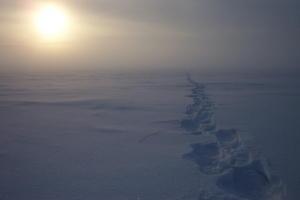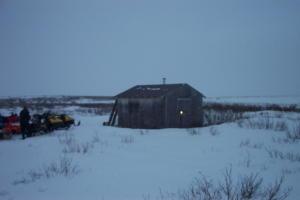2 April, 2002
The morning starts by waking up in the cold morning,
pulling on the bunny boots, eating a bowl of oatmeal,
stuffing sleeping bags, tearing down tents and packing
sleds. It's time to go to work. It's time to do what
we are here to do…. Science. A typical work day needs
to be described before further explanation of our
measurements are given. There will be detailed
lessons on each measurement but for now, the reader
needs to understand science and the amount of data
that is taken on a science expedition traverse across
Alaska.
Imagine a NASCAR race stop pit. The crew is hovering
around the car in a mad rush for new tires, checking
the engine, fueling up and then zooom the car pulls
off. Now parallel this scenario to the SnowSTAR 2002
measurement site. The 6-snowmachine crew pulls up to
the site, jumps off the snowmachines, unties and
unpacks the sled, the crew takes off with scientific
equipment in hand ready to measure the snow. It
happens efficiently. The team works as one, as a
team.
Matthew has pre-determined the measurement sites by
using GPS and topographical maps. The sites are
chosen according to vegetation: either tundra or
forest. When reaching a site, the wind direction is
recorded and the line of measurements that will be
taken is determined. A 100-meter tape measurer is
pulled out. This meter tape is used to mark the
places where the measurements will be taken. Eric
takes the magna probe that is attached to the GPS and
walks the long line of approximately 1 mile which
records at least 200 measurements. Jon runs the magna
probe on the 100 meter line which records 201
measurements. I begin digging the 4 snow pits and
take 10 Snow-Water-Equivalence samples along the line.
Matthew digs the main snow pit and begins making his
100 discrete measurements of things like snow
grain-size distribution and density in the pit. Glen
and Ken run the light intensity meter which requires
the use of the heated sled and computers. It records
up to 120,000 measurements of how the sunlight
penetrates the snow. After Glen and Ken finish the
light intensity meter the pentatrometer is ran which
records up to 90,000 snow-hardness measurements. All
of these measurements are performed in approximately
2-3 hours at a given site.
On some days the technical and time consuming chemical
samples are also taken at the site.
Now double or triple all of those numbers in a given
day because two to three sites are performed each day.
All of this work is performed along with traveling up
to 20 miles a day on snowmachines. And the end of the
day arrives, camp is chosen, sleds are untied,
unpacked, an army of 6 people quickly erect two tents,
the cook stove and wood stove is set up, snow is
melted for water, dinner is fixed, data is processed,
journals are written, jokes are told, people depart to
beds of sleeping bags. It's been another day of cold
science on the Alaska range.
SO WHERE IS MRS. CHEUVRONT???? LET'S PLOT!!! We've
made it past the Arctic Circle!!!
Latitude: 66.51964 degrees North
Longitude: 160.18114 degrees west
The shelter was left in the morning and the caravan of
snowmachines traveled onward. Two complete sites were
finished and we jostled and bumped along the trail.
My eyes spotted a fox running across the tundra. It
sat upright for a minute and studied us as we studied
him. We continued to travel 22 miles across the frozen
and snow-covered Selawik lake. The air temperature
had dropped and we were surrounded by ice fog. The
lake appeared eerie in parts scattered with pressure
ridges of ice. The colder temperatures and fog has
brought us across the Arctic Circle. We camp tonight
at the base of huge snowdrifts, sculpted by the wind.
The Arctic is here. I have arrived. It has greeted me
with cold.
Temp max: -2 degrees Celsius
Temp min: -11 degrees Celsius

Footprints in the fog marked our path to the Arctic.

A cabin that provided us much needed shelter along the trail to Selawik.
Contact the TEA in the field at
.
If you cannot connect through your browser, copy the
TEA's e-mail address in the "To:" line of
your favorite e-mail package.
|
